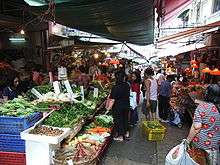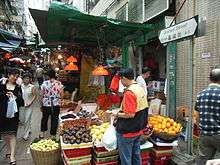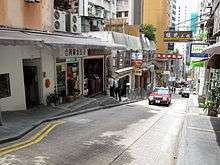Graham Street



Graham Street (Chinese: 嘉咸街) is a street in Hong Kong and the location of Graham Street Market, one of the oldest continuously operating street markets in Hong Kong.
Location
Located in Central, Hong Kong Island, the street starts from Queen's Road Central and runs uphill and south to Staunton Street, crossing Stanley Street, Wellington Street, Gage Street, Lyndhurst Terrace and Hollywood Road. The Street Market occupies the section between Queen's Road Central and Hollywood Road.[1]
History
The market dates back more than 160 years.[1] The street is narrow but allows a row of stalls on either sides and sells various foodstuff.[2]
One of the earliest cinemas in Hong Kong, the Bizhao Dianying Yuan, opened in Graham Street in 1907.[3]
Queen Elizabeth II, accompanied by Governor Murray MacLehose, visited the Graham Street market on 5 May 1975 to speak with locals.
Graham Street was featured in a scene from the 2001 film Rush Hour 2.
The Urban Renewal Authority is redeveloping Graham Street and Peel Street and planning to demolish the market. This will affect over 37 buildings in the process.[4]
References
- 1 2 Best wet markets in Hong Kong CNN Go. 23 September 2011. Retrieved 2011-10-09
- ↑ DeWolf, Christopher "9 Hong Kong tourist traps -- for better or worse" CNN Go. 27 October 2010. Retrieved 2012-03-03
- ↑ Pang, Laikwan (2007). The distorting mirror: visual modernity in China. University of Hawaii Press. p. 167. ISBN 978-0-8248-3093-9.
- ↑ Urban Renewal Authority: Peel Street / Graham Street Project
External links
| Wikimedia Commons has media related to Graham Street, Hong Kong. |
- HK magazine: "Marked for Death", July 20th, 2007
- HK magazine: "Market Raiders", September 14th, 2007
- HK magazine: "Market Values", February 1st, 2008
- Kinoshita, Hikaru (2001). "Chapter 2: The Street Market as an Urban Facility in Hong Kong". In Miao, Pu. Public places in Asia Pacific cities: current issues and strategies. Springer. pp. 71–86. ISBN 978-0-7923-7083-3.
- Wordie, Jason (2002). Streets: Exploring Hong Kong Island. Hong Kong: Hong Kong University Press. pp. 34–39. ISBN 962-209-563-1.
Coordinates: 22°16′58″N 114°09′12″E / 22.28278°N 114.15326°E